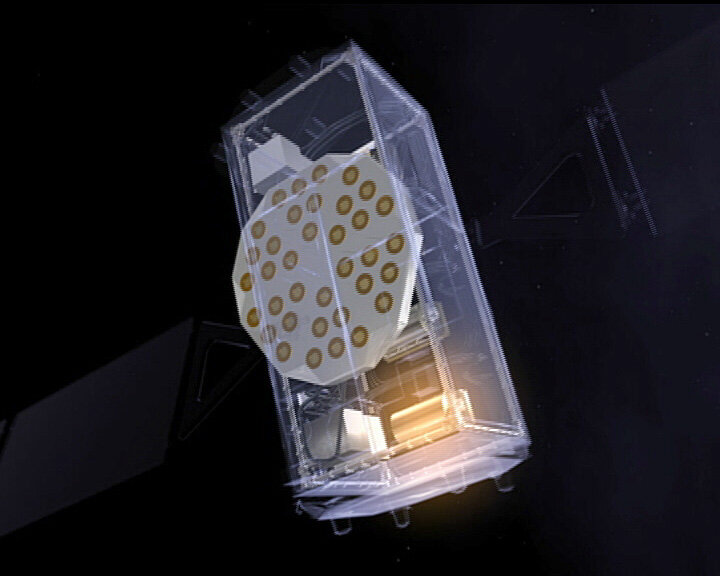Contract for new Galileo atomic clock tech signed
ESA, on behalf of the European Commission, has signed a €12 million contract with Leonardo S.p.A (Italy) and Istituto Nazionale di Ricerca Metrologica to design and develop a new ultra-precise atomic clock technology for Galileo.
Ultra-precise and reliable atomic clocks are an essential pillar in satellite navigation, driving overall system performance and positioning accuracy. From the drawing board to being operational in space, a full technology innovation cycle can take up to a decade, so to keep Galileo at the forefront of global satnav ESA is continually undertaking research and development for the evolution of both Galileo and EGNOS via the EU programme Horizon Europe.
Last month, ESA kicked off a new project to design, develop and qualify a new technology for atomic clocks. On behalf of the European Commission and after a formal selection process under open competition, ESA signed a contract for an amount of €12 million with a consortium formed by the Italian company Leonardo S.p.A as prime contractor and Istituto Nazionale di Ricerca Metrologica (INRiM) as subcontractor. As part of the R&D workplan for Galileo, ESA will also assess other clock technologies, the procurement of which is still ongoing.
“The pulsed optically pumped rubidium atomic clock under development combines the robustness of rubidium vapour cell atomic clocks, largely used in satellite navigation constellations like Galileo, with state-of-the-art optical and digital technologies,” explains Manuela Rapisarda, GNSS Evolutions Payload Principal Engineer at ESA.
Under this contract, the consortium will design, manufacture, test and qualify an engineering qualification model, after which an experimental flight model is expected to fly on a Galileo Second Generation satellite for early in-orbit verification. After initial tests, the new clock will still be monitored to study its reliability and long-term lifetime. Experimental clocks will fly in addition to the operational clocks that are used in the provision of Galileo services.

Galileo is one of the most crucial space-based infrastructures in Europe. “If qualified, the new clock technology will not only contribute to improving its performance but will guarantee Europe to stay at the forefront of atomic clock technology,” says Pascale Flagel, Head of Galileo and EGNOS Evolution Division.
Apart from investing in the development of new clock technology, Horizon Europe is also running research and development activities on other aspects for the evolution of EGNOS and Galileo, both in space and on the ground, to leverage emerging trends and address evolving user needs.
Mastering timekeeping in space

The capability of a satellite navigation system to pinpoint a location stems from calculating the time it takes for a signal to travel from the satellite to a receiver. Galileo satellites orbit 23 222 km above Earth, transmitting signals that incorporate a time stamp. Since the propagation speed of the signal is known, the difference between the transmission and reception time determines the distance of the user with respect to the satellite. It is possible to determine the user position on Earth knowing its distance from at least four satellites.
The signal transmitted by the satellite takes around a twelfth of a second to reach the user on Earth. Positioning accuracy is therefore linked to Galileo’s timing precision which needs to be within few nanoseconds – billionths of a second – in order to have a positioning accuracy of meters.

Currently, Galileo satellites of the first generation carry passive hydrogen masers, also developed by Leonardo and the most precise clocks in orbit to this date, and rubidium clocks, supplied by Safran. The new alternative atomic clock technology subject of the signed contract is expected to be even more precise than any of the current Galileo clocks, with a decrease in energy consumption and a mass reduction of more than 40% with respect to Galileo passive hydrogen maser clocks.
With the ultra-precise clocks currently flying on Galileo, the new pulsed optically pumped rubidium atomic clock and other innovative clock technologies now in early research stages, Galileo is in an excellent position to evolve and remain the best satellite navigation system in the world.
About Horizon Europe
Horizon Europe is the EU’s key funding programme for the evolution of EGNOS and Galileo, to ensure continuity of service, increased accuracy of positioning and stronger robustness against threats.
ESA has been entrusted with bringing innovative technologies for EGNOS and Galileo to maturity, reducing risks and securing operational systems for the future. Research and innovation happen in close coordination with national space agencies, as well as industry and research institutions.
Horizon Europe builds on Horizon 2020, a funding programme that enabled the development of novel technologies which will now be used in Galileo Second Generation space and ground segments.
Galileo and EGNOS are flagship programmes of the European Union, managed and funded by the European Commission. Since their inception, ESA leads the design, development and qualification of the space and ground systems, as well as procuring launches. The EU Agency for the Space Programme (EUSPA) acts as the service provider, overseeing the market and application needs and closing the loop with users.
For more info about Horizon Europe: Horizon Europe - European Commission (europa.eu)















 Germany
Germany
 Austria
Austria
 Belgium
Belgium
 Denmark
Denmark
 Spain
Spain
 Estonia
Estonia
 Finland
Finland
 France
France
 Greece
Greece
 Hungary
Hungary
 Ireland
Ireland
 Italy
Italy
 Luxembourg
Luxembourg
 Norway
Norway
 The Netherlands
The Netherlands
 Poland
Poland
 Portugal
Portugal
 Czechia
Czechia
 Romania
Romania
 United Kingdom
United Kingdom
 Slovenia
Slovenia
 Sweden
Sweden
 Switzerland
Switzerland

























